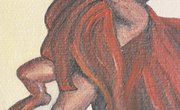"Wuthering Heights" is Emily Bronte's only novel, and it tells the tale of star-crossed lovers Catherine and Heathcliff. Catherine refuses to be with Heathcliff because he is poor, so Heathcliff goes off to win his fortune, only to return home to find her married to Edgar. The novel employs a complex narrative structure to tell this tale, which winds on for many decades and includes many plot twists and turns along the way.
Multiple Narrators
The novel employs two primary narrators: Lockwood and Nelly. Lockwood is Heathcliff's tenant in the present day, and he wants to learn more about the mysterious man. His narration provides a frame narrative for the story. Lockwood learns the back story of Heathcliff, Catherine and the other residents of Wuthering Heights and Thrushcross Grange from the housekeeper, Nelly. Her narration provides the internal narrative, which is focused in the past. Other characters provide important narration through their dialogue to Nelly. By using Lockwood as the external narrator, Bronte creates some distance from the events. Then, when introducing Nelly's narrative, supported by the other characters' narratives, the novel takes on the tone of a stage drama. All of the narrators are considered unreliable, creating more intrigue around the suspenseful story.
Multiple Narratives
In addition to using multiple narrators, the novel also uses multiple narrative devices. For example, Catherine provides significant narration through her diary, as does Isabella in a letter that she writers to Nelly. Each of these devices allows the characters to provide extensive, first-person narration, which gives important intimate details about the story. Catherine's narration reveals her conflicted feelings about Heathcliff, showing his softer side. Meanwhile, Isabella's letter reveals the lengths to which Heathcliff will go for revenge, revealing his darker nature. These internal narrative devices help to provide more nuance into the already complex series of events.
Time Shift
The shift between Lockwood and Nelly's narratives also represents a shift between past and present. The novel starts in the present day, when Heathcliff appears to be an irredeemable and evil man and Catherine is only a ghost, whether just haunting Heathcliff's mind or physically haunting the manor, as he suggests. By starting in the present day, the novel shows just how desperate the situation has become. The reader knows from the start that the story will not end happily. This creates suspense about how the events will unfold.
Gloomy Setting
The choice of setting is another significant narrative technique. The moors are dark, stormy and gloomy, which reflects the tone of the story. The novel begins and ends with gloomy circumstances. There are few moments of levity throughout, and even those are overshadowed by a sense of foreboding, such as Catherine knowing that she will never marry Heathcliff, even though she loves him. The narrative's interior is just as stormy as the moors outside.
Related Articles
References
Writer Bio
Maria Magher has been working as a professional writer since 2001. She has worked as an ESL teacher, a freshman composition teacher and an education reporter, writing for regional newspapers and online publications. She has written about parenting for Pampers and other websites. She has a Master's degree in English and creative writing.











